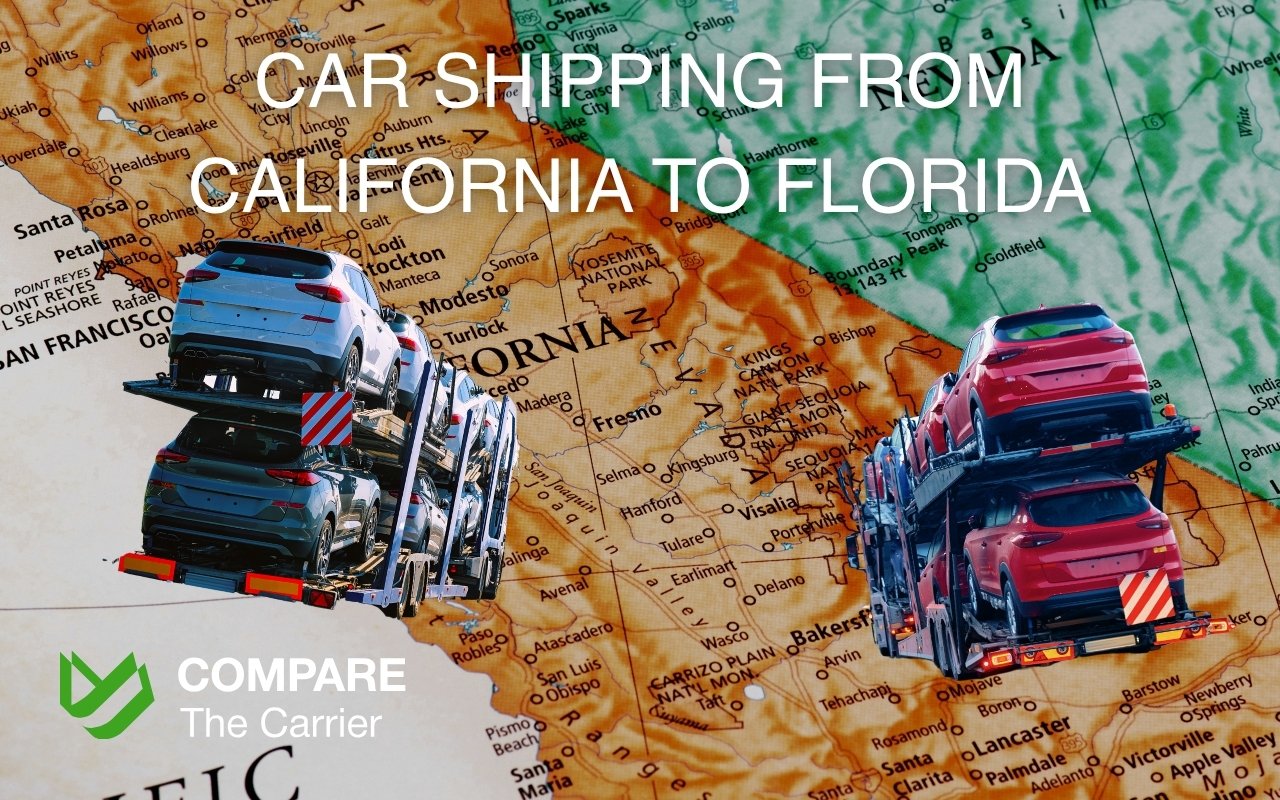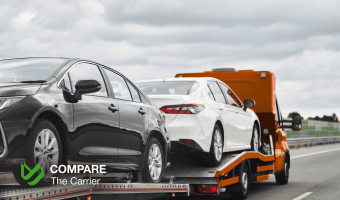Why Ship a Car from California to Florida?
According to the U.S. Census Bureau’s 2024 migration report, over 135,000 Californians moved to Florida last year alone—a 12% increase from 2023. Whether it’s snowbirds seeking warm winters, students transferring between universities, military relocations, or families starting anew, one thing’s clear: car shipping from California to Florida is in high demand. And for good reason.
Driving 2,700+ miles from CA to FL is not only time-consuming (think 40+ hours on the road), it’s also expensive when you factor in gas, food, hotels, and potential vehicle wear. That’s where auto transport from California to Florida comes in—a streamlined solution that’s often more cost-effective and far more convenient.
By working with a trusted auto transporter, you get the benefit of fast and safe delivery, door-to-door service, and the peace of mind that your vehicle will arrive in the Sunshine State in the same condition it left the Golden State. But here’s where many people run into trouble: not all carriers are equal. Scams, delays, and surprise fees plague the industry. That’s exactly why CompareTheCarrier.com exists—to help you ship a car from California to Florida without the usual headaches.
Whether you’re an auto dealer needing to relocate inventory, a retiree chasing the sun, or a student getting ready for your new semester, this guide breaks down the entire California to Florida vehicle transport process—step by step. We’ll cover pricing, timelines, tips for safe shipping, and how to avoid the most common pitfalls. Let’s dive in.
How Auto Transport Works from California to Florida
Shipping a car from California to Florida might seem like a complex process, but it’s actually quite straightforward when you understand how the system operates. At its core, cross-country car shipping from California to Florida follows a structured series of steps, handled by professionals to ensure your vehicle is transported safely and efficiently.
Step-by-Step Overview of the Auto Transport Process
- Quote & Booking:
Start by getting multiple quotes from licensed carriers or brokers through a comparison platform like CompareTheCarrier.com. This is your best bet to evaluate different options, including service types and pricing. - Choose Open or Enclosed Transport:
Most customers opt for open transport due to its affordability and availability. However, if you’re shipping a luxury, vintage, or specialty car, enclosed transport provides extra protection from weather and road debris. - Vehicle Pickup:
Once you book, the carrier schedules a pickup date. They’ll arrive at your chosen location—whether that’s your home, dealership, or storage facility. You’ll complete a Bill of Lading (BOL), which documents the car’s condition before shipment. - Cross-Country Transit:
The actual journey begins. Your car is loaded onto a transport truck with up to 9 other vehicles (for open transport), or a few select vehicles (for enclosed). The route from CA to FL includes major highways like I-10 or I-40, depending on weather and traffic. - Car Delivery in Florida:
On delivery day, you or a representative will meet the driver, inspect the car, and confirm that it arrived in the same condition. Sign the BOL again to complete the transaction.
Types of Auto Transport Available
- Open Carrier Transport: The most common and economical choice. It’s what you’ve likely seen on highways—multi-car trailers with exposed vehicles.
- Enclosed Carrier Transport: Offers greater protection and is preferred for high-value vehicles. It costs more but shields the car from the elements.
- Door-to-Door Service: The carrier picks up and delivers as close as possible to your requested addresses.
- Terminal-to-Terminal Shipping: Less common today, but occasionally used when door access is restricted.
Every year, thousands of vehicles make the trip from the West Coast to the Southeast via these services. FMCSA-registered carriers (Federal Motor Carrier Safety Administration) must comply with federal safety standards, so always check a company’s USDOT number at FMCSA’s website.
CompareTheCarrier only works with top-rated auto shipping services—those with five-star reviews, active licensing, and a history of fast and safe delivery. That’s how you ensure a seamless experience when booking auto transport California to Florida.
Should You Use a Broker or Book Direct with a Carrier?
When arranging California to Florida car shipping, one of the most important choices you’ll make is whether to work with a broker or go directly to a carrier. Each option has its pros and cons, and understanding the difference can save you time, money, and frustration.
What’s the Difference?
- Carriers are the companies that physically transport your vehicle using their own fleet of trucks and drivers.
- Brokers are intermediaries who connect you with a network of carriers. They don’t own trucks but act as logistics coordinators to find the best match for your specific needs.
Pros and Cons of Using a Broker
Pros:
- Wider Access: Brokers have access to thousands of FMCSA-licensed carriers. That means more options, better pricing, and faster scheduling.
- Convenience: You don’t have to call dozens of carriers yourself. Brokers handle the legwork, including vetting drivers and coordinating pickup/delivery.
- Competitive Pricing: Brokers can negotiate better rates by shopping around on your behalf.
Cons:
- Variable Quality: Some brokers prioritize price over quality, booking with low-rated or unreliable carriers. Always check their reviews and BBB accreditation.
- Less Control: You may not know which exact carrier will move your car until shortly before the pickup.
Pros and Cons of Booking Direct with a Carrier
Pros:
- Direct Communication: You deal directly with the company transporting your car—helpful for special requests or last-minute changes.
- Consistency: Some people feel more comfortable dealing with a single company throughout the process.
Cons:
- Limited Options: Direct carriers may only service certain routes, dates, or vehicle types. If they’re fully booked or don’t operate the route from CA to FL, you’re out of luck.
- More Time-Consuming: You’ll need to do your own research on reliability, licenses, and insurance coverage.
The Smartest Approach: Use a Trusted Comparison Platform
The best of both worlds? Use a trusted comparison service like Compare The Carrier, which combines the broad reach of a broker with a commitment to only working with verified, five-star carriers. This removes the guesswork and connects you to the best car shipping company for your needs—from luxury enclosed transport to budget-friendly open carriers.
Real case: One customer, a car collector from Los Angeles, used CompareTheCarrier to ship a restored ’67 Mustang to Tampa. He was matched with a top-rated auto shipping provider that specialized in classic car transport. The car arrived two days early and in pristine condition—proof that working with curated options really pays off.

Cost to Ship a Car from California to Florida
When planning auto transport California to Florida, one of the first questions most people ask is: “How much will it cost?” The answer isn’t one-size-fits-all, but having a clear idea of pricing averages and influencing factors will help you budget smartly—and avoid being overcharged.
Average California to Florida Car Shipping Cost
As of Q2 2025, the average cost to ship a car from California to Florida ranges between $1,100 and $1,600 for standard open transport. Enclosed transport, which offers more protection, typically costs $1,500 to $2,100.
| Type of Transport | Average Cost (CA to FL) |
| Open Carrier | $1,100 – $1,600 |
| Enclosed Carrier | $1,500 – $2,100 |
| Expedited Delivery | +$200 – $500 extra |
| Inoperable Vehicle | +$100 – $200 extra |
Note: These are general estimates based on a mid-size sedan like a Toyota Camry or Honda Accord. SUVs, trucks, and luxury vehicles may cost more due to size, weight, or value.
Pricing Example
- A college student shipping a 2021 Toyota Corolla from Los Angeles to Orlando using open transport might pay around $1,250, assuming flexible pickup dates.
- A snowbird transporting a 2023 BMW X5 in an enclosed trailer to Naples, FL could expect a quote around $1,950, especially during peak season (October–December).
These estimates reflect industry averages reported by leading auto shipping review platforms, including uShip and Move.org, and align with real-time quotes from verified carriers listed on CompareTheCarrier.com.
Quick Tip
Always compare at least 3-5 quotes to avoid being overcharged or undersold. Rock-bottom prices often come with hidden risks—like last-minute cancellations, delays, or poorly rated carriers. That’s why comparison platforms are so valuable. They help you pinpoint the best car shipping company based on cost and reputation.
What Impacts the Final Shipping Price?
Understanding what drives the California to Florida vehicle transport cost can help you make smarter decisions—and potentially save hundreds of dollars. While quotes vary, several key factors influence how much you’ll pay to ship a car from California to Florida.
1. Type of Transport: Open vs. Enclosed
This is the biggest factor in price variation.
- Open transport is more affordable and widely available. It’s the go-to for most everyday vehicles.
- Enclosed transport costs more (typically 30–50% higher), but offers added protection from weather, debris, and theft—ideal for classic, luxury, or exotic cars.
2. Vehicle Type, Size, and Weight
- A compact car like a Honda Civic costs less to transport than a full-size SUV or pickup truck.
- Heavier vehicles take up more space on the carrier and require more fuel, which increases cost.
- Modified cars or those with oversized tires, lowered suspensions, or other customizations may require special handling and pricing.
3. Distance and Route
The distance from pickup to delivery matters, of course—but the route’s popularity does too.
- Major metro-to-metro shipments (e.g., Los Angeles to Miami) are cheaper due to higher demand and more frequent routes.
- Remote or rural pickups and drop-offs can increase pricing because carriers must go out of their way, using extra fuel and time.
4. Timing and Seasonality
Like flights and hotels, car shipping prices fluctuate by season:
- Peak season (October–April for snowbirds and retirees) usually sees higher demand and prices.
- Off-season (late spring to early summer) may offer better deals if you’re flexible.
Shipping with flexible dates lets brokers or carriers match your car with the most efficient route, potentially saving you money.
5. Vehicle Condition
- Running cars are easier (and cheaper) to load and unload.
- Inoperable vehicles require a winch or forklift, adding $100–$200 to the cost.
6. Expedited Delivery
Need your car moved ASAP? Expect to pay an extra $200 to $500 for priority scheduling. Not all carriers offer this service, and availability depends on your location and time of year.
7. Insurance and Coverage
All licensed carriers must provide basic liability coverage, but this might not fully cover the value of your car, especially in the case of damage. Reputable brokers or comparison platforms like CompareTheCarrier will help you verify insurance levels and recommend extra coverage if needed.
Real-World Insight
A family relocating from San Diego to Jacksonville shared this review on CompareTheCarrier:
“We had a 2018 Ford Explorer. After comparing five quotes, we saved $375 by being flexible on pickup dates. Our driver had five-star reviews and was incredibly professional. The car arrived a day early—completely stress-free!”

How Long Does Car Shipping Take from California to Florida?
When you’re planning a cross-country move or purchase, knowing the delivery window for your vehicle is just as important as the price. So how long does car shipping from California to Florida really take?
Average Timeframe for California to Florida Auto Transport
For most standard shipments, you can expect a delivery window of:
7 to 10 days from pickup to delivery
This estimate is based on typical driving conditions and assumes a direct route—like Los Angeles to Miami or San Francisco to Orlando. Carriers typically cover 400 to 500 miles per day, depending on road conditions, stops, and loading/unloading.
| Route Example | Distance (Approx.) | Average Transit Time |
| Los Angeles to Tampa | 2,500 miles | 7–9 days |
| San Diego to Jacksonville | 2,400 miles | 6–8 days |
| San Jose to Miami | 2,900 miles | 8–10 days |
Factors That Affect Delivery Time
- Carrier Schedule & Route:
Most trucks don’t drive directly from Point A to Point B—they have multiple pickups and drop-offs along the way. If you’re first on the route, your car may arrive sooner. If you’re last, it could take a few more days. - Transport Type:
Enclosed carriers typically carry fewer vehicles, so they may reach their destinations quicker than open car shipping with a full load. - Weather & Road Conditions:
Severe weather, traffic, or road closures (especially in mountainous areas or storm-prone regions) can delay transport. - Seasonal Demand:
During snowbird season or around holidays, demand spikes. This can cause scheduling backlogs, especially in California’s larger cities like Los Angeles, San Diego, and San Jose. - Pickup Flexibility:
More flexible scheduling often allows you to be matched with a faster route. Expedited shipping is also available—for a price.
Pro Tip: Communication is Key
Reputable carriers and brokers will keep you updated throughout the shipping process. Look for companies with strong customer support and real-time tracking, especially if you’re on a tight timeline.
“I shipped my Tesla Model Y from San Jose to Fort Lauderdale using an enclosed carrier. The driver updated me daily. The car arrived two days early and spotless!” – Verified Compare The Carrier customer, 2025.
How to Get Your Car Ready for Transport
Preparing your car for auto transport from California to Florida is a crucial step that can help prevent damage, reduce delays, and ensure a smoother shipping process. Whether you’re using open or enclosed transport, following a few best practices can save you time, stress, and potentially even money.
Here’s a comprehensive checklist to get your vehicle road-trip-ready for a cross-country hauler:
1. Clean Your Car Inside and Out
A clean vehicle allows for a more accurate inspection before shipping. You and the carrier will perform a walk-around during pickup to note any existing damage—scratches, dings, dents. Dirt and grime can hide imperfections, which may cause disputes later.
- Wash the exterior thoroughly.
- Remove all personal items, trash, and valuables from inside the car.
2. Document the Vehicle’s Condition
Take clear, time-stamped photos of your vehicle from all angles, including close-ups of any existing damage. Keep these for your records. If a dispute arises over scratches or dents, you’ll have solid evidence.
3. Remove Personal Belongings
While it might be tempting to use your vehicle as a moving box, carriers aren’t legally allowed to transport household goods. Plus, loose items can move during transit and cause interior damage.
- Remove electronics, chargers, E-ZPass devices, and anything not permanently affixed.
- Don’t leave luggage, tools, or sports gear in the trunk unless the carrier approves it.
4. Check for Leaks and Maintenance Issues
Your car doesn’t need to be in perfect shape, but it should be operational—unless you’ve booked special service for a non-running vehicle.
- Top off fluids, check tire pressure, and inspect for leaks.
- Let the carrier know if there are any quirks (e.g., difficult ignition, faulty brakes).
5. Keep It Light on Gas
Most carriers recommend keeping your fuel tank about ¼ full. That’s enough for loading and unloading, but not so much that it adds unnecessary weight to the carrier.
6. Disable Alarms and Toll Tags
- Turn off or disconnect any alarms to avoid unnecessary alerts during transport.
- Remove or deactivate toll transponders like FasTrak or SunPass—they may rack up charges as the truck passes through toll zones.
7. Secure or Fold Down Loose Parts
This applies especially if you’re using open transport:
- Retract or remove antennas.
- Fold in side mirrors.
- If you have custom spoilers or roof racks, ask the carrier if they need to be removed.
8. Keep a Spare Key Handy
Give the driver a spare key, not your only one. They may need to move the vehicle during loading/unloading or in case of emergency.
What Happens on Delivery Day in Florida?
Delivery day is the final and most anticipated step in the California to Florida car shipping journey. Whether you’re receiving your car at your new home, a storage facility, or meeting the driver at a nearby parking lot, knowing what to expect helps ensure a smooth handoff.
Here’s how the process typically unfolds:
1. The Carrier Will Contact You in Advance
Reliable carriers usually call 12–24 hours ahead of time to confirm the exact delivery window. You or a designated representative must be available to meet the driver, inspect the vehicle, and sign paperwork.
Tip: If you’re in a gated community, apartment complex, or have tight street access, arrange to meet the driver at a nearby open area—like a supermarket or school parking lot. Most trucks are too large for residential streets.
2. Final Vehicle Inspection
Before unloading your car, the driver will do a second walk-around inspection with you. You’ll compare the vehicle’s current condition to the original Bill of Lading (BOL) from pickup day.
- If the vehicle arrives in the same condition, you’ll sign off, acknowledging safe delivery.
- If any damage is found, make sure it’s documented in writing on the BOL and supported by new photos.
This documentation is crucial if you need to file an insurance claim with the carrier. Don’t rush this step.
3. Pay Any Remaining Balance
Depending on how you booked your shipment, you might need to pay the remaining balance at delivery. Most carriers accept:
- Cash
- Cashier’s check
- Money order
Some carriers now accept Zelle or other digital transfers—but confirm payment methods ahead of time to avoid surprises.
4. Enjoy Peace of Mind (and Your Car!)
Once the inspection is complete and everything is signed, you’re good to go. Most CompareTheCarrier clients report receiving their vehicle in excellent condition and ahead of schedule, thanks to the platform’s strict quality control over its network of trusted auto transporters.

Why Compare The Carrier Is the Smarter Way to Ship
When it comes to cross-country car shipping from California to Florida, finding a reliable carrier is just as important as finding a good price. That’s where Compare The Carrier truly stands out. It’s not just a quote engine—it’s a full-service comparison platform built specifically to help consumers avoid the risks of shipping scams, unreliable drivers, and hidden fees.
Here’s why Compare The Carrier is the smarter, safer way to ship your vehicle from CA to FL:
1. Vetted, FMCSA-Licensed Carriers Only
CompareTheCarrier only partners with auto transport companies that are fully licensed, bonded, and insured. Every transporter listed is verified with the Federal Motor Carrier Safety Administration (FMCSA) and has a clean safety record.
No shady outfits. No “fly-by-night” drivers. No corner-cutting.
2. Real Reviews. Real Results.
Unlike other platforms that flood you with anonymous or fake quotes, CompareTheCarrier showcases real user reviews, transparent ratings, and verified delivery success. You can filter by services like:
- Five-star reviews
- Enclosed or open transport
- Vehicle tracking
- BBB accreditation
- Years in business
This helps you quickly spot the best car shipping company for your specific needs—whether you’re moving a classic car, a family SUV, or an inoperable vehicle.
3. Competitive, Transparent Pricing
Because it sources from a large pool of top-rated auto shipping providers, CompareTheCarrier delivers pricing that’s not just competitive—but tailored to your shipment. And unlike aggregator sites that sell your info to the highest bidder, this platform protects your privacy and never bombards you with spam calls.
You’ll receive side-by-side quotes with full breakdowns of:
- Base shipping rate
- Fuel surcharges (if any)
- Insurance coverage
- Optional services (e.g., enclosed trailer or expedited delivery)
4. Fast & Friendly Customer Support
Customer support is where most carriers drop the ball. Not CompareTheCarrier. They provide live U.S.-based support, available to answer questions before, during, and after your shipment.
From help decoding quotes to resolving payment issues or finding alternate drop-off spots in Florida, their reps are known for proactive, hands-on service.
“After a bad experience with another company, I tried CompareTheCarrier. I instantly got matched with three carriers that had five-star reviews. One even called me personally to confirm every detail. My SUV arrived two days early, in perfect condition.” – Jodi A., Tampa, FL
5. Free, No-Obligation Quotes
You can test-drive the service by requesting a free quote in under 60 seconds—no credit card, no strings attached. It’s the easiest way to get a real feel for what your California to Florida vehicle transport will cost, without committing to anything upfront.
Conclusion – California to Florida—Made Easy with the Right Partner
Shipping a car from California to Florida doesn’t have to be stressful, risky, or expensive. With the right preparation, trusted service providers, and a little industry insight, it can be a smooth, straightforward experience—whether you’re a snowbird, college student, car dealer, or relocating family.
The key is working with professionals who know the ins and outs of auto transport California to Florida—and that’s exactly what CompareTheCarrier.com was built for.
Instead of gambling on a random name from a search result or overpaying through a high-pressure sales pitch, you can compare verified, FMCSA-licensed carriers with proven track records of safe, fast delivery and five-star service. You get the tools to make informed choices—custom quotes, service filters, honest reviews—and the customer support to back you up every mile of the way.
From Los Angeles to Miami, San Francisco to Orlando, or San Diego to Jacksonville, CompareTheCarrier helps you ship smarter, safer, and more affordably—so your vehicle arrives on time and in great shape, no matter where in Florida you’re headed.
Get started today by requesting your free quote—no pressure, no spam, just real results from top-rated auto shipping experts you can trust.
Cross-country car shipping from California to Florida? Now, it’s easier—and smarter—than ever.
FAQ
Here are answers to the most common questions people have about shipping a car from California to Florida. Whether it’s your first time or you’re a seasoned shipper, these insights will help you navigate the process like a pro.
How much does it cost to ship a car from California to Florida?
The average California to Florida car shipping cost ranges from $1,100 to $1,600 for open transport and $1,500 to $2,100 for enclosed transport. Final pricing depends on the vehicle type, distance, transport type, and season.
How long does auto transport take from California to Florida?
Typically, cross-country car shipping California to Florida takes 7 to 10 days. Timeframes vary based on route, weather, and how many pickups and deliveries are on the truck’s schedule.
Is open transport safe?
Yes—open transport is the industry standard and used by dealerships nationwide. It’s safe for most cars, though high-value, luxury, or classic vehicles may benefit from enclosed shipping.
Can I ship a non-running vehicle?
Yes, but it will require special equipment (like a winch) and will increase your price by $100–$200. Always inform the carrier in advance if your car is inoperable.
Can I put personal items in the car?
Technically, no. FMCSA regulations prohibit the transport of household goods in vehicles. Some carriers allow up to 100 lbs in the trunk, but it’s best to confirm beforehand.
Should I use a broker or a carrier directly?
Brokers offer more flexibility and options, while direct carriers may offer more personalized service. The smartest route? Use a comparison platform like Compare The Carrier to get licensed, top-rated auto shipping options with competitive pricing.
What paperwork is required?
Most shipments only require: Photo ID, Vehicle registration, Signed Bill of Lading (BOL) at pickup and delivery.
If the car is being shipped on your behalf, provide a signed letter of authorization for the driver.
Will my car be insured during shipping?
Yes, all FMCSA-licensed carriers are required to carry liability and cargo insurance. Be sure to ask for proof and review coverage limits. For high-value vehicles, consider supplemental coverage.
What if my delivery address isn’t accessible by truck?
Most carriers offer door-to-door service, but if access is tight (e.g., gated communities or urban areas), the driver will arrange a nearby public location for drop-off.
What’s the best time to ship a car from CA to FL?
Avoid peak months (October–April) if possible. For better availability and pricing, ship during off-season or book at least 2 weeks in advance.
How do I track my vehicle during transport?
Many top-rated auto shipping companies offer GPS tracking or driver updates by phone/text. When booking through Compare The Carrier, you’ll know exactly how to stay in touch.
Can I cancel or reschedule my shipment?
Yes, but cancellation fees may apply depending on how close it is to your pickup date. Always check the terms before booking—and opt for a carrier with flexible customer support.













